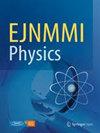基于数据驱动门控(DDG)的运动匹配改进 CTAC 套准
IF 3
2区 医学
Q2 RADIOLOGY, NUCLEAR MEDICINE & MEDICAL IMAGING
引用次数: 0
摘要
呼吸运动伪影是胸部 PET/CT 成像的一个隐患。PET 图像中的运动伪影来源于用于图像衰减校正的 CT。采集螺旋 CT($$h\box{CT}_{text{helical}}$$)时的任意呼吸相位经常会造成 PET 和 CT 图像之间的错误配准,从而导致 PET 图像的衰减校正不准确。因此,肿瘤划分或病灶摄取值可能会出现误差。为了将 PET/CT 成像中的运动影响降至最低,我们开发了一种基于数据驱动门控(DDG)的运动匹配(MM)算法,该算法可估算 $$\hbox{CT}_{text\{helical}}$ 的相位,随后将 CT 扭曲到呼吸周期的给定相位,使其与 PET 相位匹配。我们使用了一组与 PET/CT 同时采集的四维 CT(4DCT)数据。4DCT 可生成地面真实 CT 相位,并与算法生成的运动匹配 CT (MMCT) 进行比较。通过CT图像测量肝脏和病变边缘位置,以确定任何差异,并确定算法在将$$\hbox{CT}_{text\{helical}}$$翘曲到给定相位(期末,EE)方面的性能如何。虽然 4DCT 和 MMCT 在肝脏测量方面存在微小差异($$p = 0.045$$),但 4DCT 和 MMCT 在病变测量方面没有发现显著差异($$p = 1.0$$)。在所有情况下,$$hbox{CT}_{text{helical}}$$ 都与 4DCT 有显著差异($$p < 0.001$$)。因此,在翘曲 CT 生成方面,可以认为 4DCT 和 MMCT 是等价的,这表明基于 DDG 的 MM 算法是成功的。MM 算法成功地实现了 $$hbox{CT}_{text{helical}}$$ 与地面真实 4DCT 的 EE 的相位匹配。这将减少 PET/CT 注册造成的运动伪影,而无需增加患者剂量(4DCT 需要)。本文章由计算机程序翻译,如有差异,请以英文原文为准。
Data-driven gating (DDG)-based motion match for improved CTAC registration
Respiratory motion artefacts are a pitfall in thoracic PET/CT imaging. A source of these motion artefacts within PET images is the CT used for attenuation correction of the images. The arbitrary respiratory phase in which the helical CT ( $$\hbox{CT}_{\text{helical}}$$ ) is acquired often causes misregistration between PET and CT images, leading to inaccurate attenuation correction of the PET image. As a result, errors in tumour delineation or lesion uptake values can occur. To minimise the effect of motion in PET/CT imaging, a data-driven gating (DDG)-based motion match (MM) algorithm has been developed that estimates the phase of the $$\hbox{CT}_{\text{helical}}$$ , and subsequently warps this CT to a given phase of the respiratory cycle, allowing it to be phase-matched to the PET. A set of data was used which had four-dimensional CT (4DCT) acquired alongside PET/CT. The 4DCT allowed ground truth CT phases to be generated and compared to the algorithm-generated motion match CT (MMCT). Measurements of liver and lesion margin positions were taken across CT images to determine any differences and establish how well the algorithm performed concerning warping the $$\hbox{CT}_{\text{helical}}$$ to a given phase (end-of-expiration, EE). Whilst there was a minor significance in the liver measurement between the 4DCT and MMCT ( $$p = 0.045$$ ), no significant differences were found between the 4DCT or MMCT for lesion measurements ( $$p = 1.0$$ ). In all instances, the $$\hbox{CT}_{\text{helical}}$$ was found to be significantly different from the 4DCT ( $$p < 0.001$$ ). Consequently, the 4DCT and MMCT can be considered equivalent with respect to warped CT generation, showing the DDG-based MM algorithm to be successful. The MM algorithm successfully enables the phase-matching of a $$\hbox{CT}_{\text{helical}}$$ to the EE of a ground truth 4DCT. This would reduce the motion artefacts caused by PET/CT registration without requiring additional patient dose (required for a 4DCT).
求助全文
通过发布文献求助,成功后即可免费获取论文全文。
去求助
来源期刊

EJNMMI Physics
Physics and Astronomy-Radiation
CiteScore
6.70
自引率
10.00%
发文量
78
审稿时长
13 weeks
期刊介绍:
EJNMMI Physics is an international platform for scientists, users and adopters of nuclear medicine with a particular interest in physics matters. As a companion journal to the European Journal of Nuclear Medicine and Molecular Imaging, this journal has a multi-disciplinary approach and welcomes original materials and studies with a focus on applied physics and mathematics as well as imaging systems engineering and prototyping in nuclear medicine. This includes physics-driven approaches or algorithms supported by physics that foster early clinical adoption of nuclear medicine imaging and therapy.
 求助内容:
求助内容: 应助结果提醒方式:
应助结果提醒方式:


